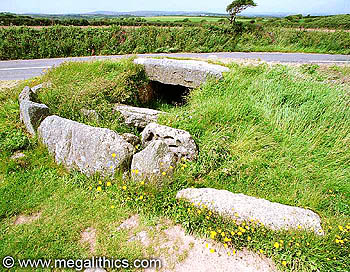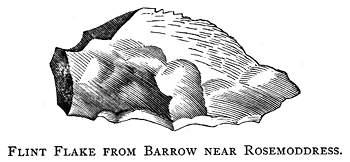
 |
Photo Gallery |
|
Panoramas |
||
Rock Art |
||
| SW 43045 24443 (GPS 46min) | |
| Visited June 2000 |
Only a short distance from the Merry Maidens stone circle and partly covered by the road, we
wonder how many visitors to the stone circle actually drive right over Tregiffian without
knowing of its existence.
As late as 1950, "Tregiffean Vean" is listed by Daniel (1) in his survey of "all known and
alleged burial chambers in southern Britain" as a "doubtful site" and he considered it to be "merely two cists of
differing dimensions placed in juxtaposition in the barrow", Hencken (2) also shared this
view. In fact, Tregiffian is a type of monument known as an Entrance Grave, these
tombs are unusual and have a very restricted distribution, click HERE for an overview of this
monument class.
Disturbed by roadmakers in the 1840's, the NW third of the cairn at Tregiffian is now under
the B3315. The mound here was originally 15m in diameter retained by the usual kerb of
large stones. Interpretation of the remains at Tregiffian today is difficult, not only because of
the intrusion of the road, but also because it seems that the monument was of multi-phase
construction, a later alteration causing an extensive re-arrangement of the kerb
layout.
Today, a good arc of contiguous kerbs are exposed at the south to SW, they stand in front of
the chamber entrance which opens to the SSW. A puzzling feature of the kerb is that it is
continuous in this region, the kerb of Entrance Graves is normally interrupted here to allow
access to the chamber. Closer examination of the kerbs before the chamber reveals an
unusually long kerb flanked by two taller stones slightly offset from the chamber axis and
this is interpreted as being a deliberate symbolic blocking, or closing of the tomb.
The entrance to the chamber was constricted by two portal stones, these stand about half a
metre behind the outer kerbs and are aligned on the outer "blocking" stone, but slightly
offset from the chamber axis. The portal stones are relatively small edge-set slabs and the western
stone is decorated with a pattern of 25 artificial hollows, most are elongated ovals, but
several are the more usual circular cupmarks. Rock art decoration is rare in this region and
the original stone has been removed to the Royal Institution of Cornwall Museum at Truro, the
stone onsite today is a casting of the original.
The chamber is 4.9m long and has composite side walls of large edge-set slabs at the front
giving way to dry stone walling towards the rear. Another unusual feature at Tregiffian is
the chamber back stone, or rather stones, as there are two of them, we could not find any
other Entrance Grave plan that showed a double back stone. The chamber was roofed with large
beam-like roof stones nearly 3m long, there were probably five originally,
four remain today. Three roof stones are in place, but the rear stone has cracked and is now supported by
a steel beam. The front roof stone of the four has fallen into the chamber and now lies
tilted behind the portal stones, obscuring the chamber structure there.
A large stone about 2m long lies outside the kerb a few metres away from the chamber at the SW and is probably
a displaced kerb or chamber element. We could find no trace of the nine foot
diameter slab mentioned by Borlase (see below).
The site has been excavated on several occasions. In 1871 the antiquary W.C.Borlase
(3) had workmen in the area to dig at the Merry Maidens stone circle,
having "been unsuccessful in his exploration" there, and still
"having the best part of the day before him" he turned his attentions
to the barrow that is now known as Tregiffian. He discovered part of the kerb,
noting that "stones on edge seemed to have formed a rude ring round
it", and then " a large stone, lying in a inclined position, nine feet
in diameter, and eighteen inches thick." On the upper surface of this stone
he found "a great quantity of ashes and splintered bone" he felt it likely
that this layer had been previously disturbed, "though never by
Archaeologists". Amongst the ashes he found the flint flake illustrated below, which he
describes as "two and a half inches long, excessively sharp, and
conveniently formed for handling as a cutting tool."

Digging under the fallen stone he found
more ashes and bone splinters, and then, under a small flat stone at the
southern end of the larger stone, he found a small pit lined with shell
sand which was "peculiar to the Cove of Portcurnow" which lay
"some three or four miles distant". Within the pit were a quantity of
ashes and bone chips which "would more than have filled a quart
measure." From the large quantity of bone discovered at the site he
concluded that more than one body had been interred.
Small
pits or scrapes containing cremated bone are a common find in Entrance Grave
chambers, as are funerary urns. Modern excavations in 1967-8 and 1972 found an additional
pit in the chamber floor containing an intact collared urn containing cremated bone. These later excavations also revealed the
secondary remodeling of the kerb, which converted the original circular arrangement into the
present smaller irregularly shaped plan. The chamber blocking stones were also incorporated
into the kerb during this second phase of construction.
Although we have not seen an accurate plan of Tregiffian, one account of the chamber
structure describes the NNE chamber side wall as bulging out slightly, this trait may have
been shared by the SSW side, but as this wall has has been damaged, this cannot
be ascertained. The bulging of the NNE wall alone would place Tregiffian in type C of the classification
scheme of Daniel (1) - chambers wider in the middle than at their ends.
It would be difficult for a monument to be closer to the road than Tregiffian, so it is very
easy to visit. It makes a very attractive double-bill for the megalithic enthusiast when
combined with a visit to the nearby Merry Maidens stone circle.
1. Daniel G.E., The Prehistoric Chamber
Tombs of England and Wales, 1950 Cambridge University Press.
2. Hencken H., The Archaeology of Cornwall and Scilly, 1932 Metheun.
3. Borlase W.C., Naenia Cornubiae 1872 Longmans.